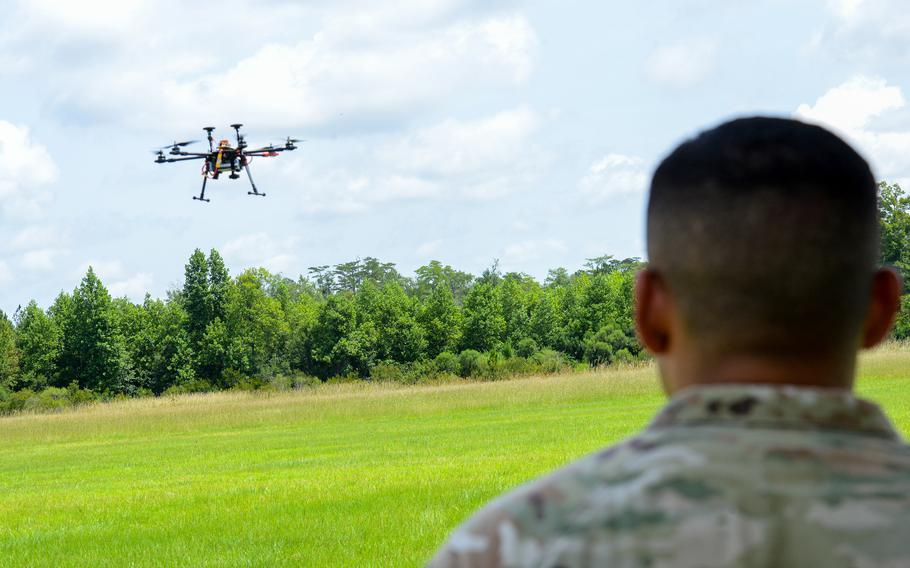
A 3rd Infantry Division soldier watches as a small drone built in a drone-building class at Fort Stewart, Ga., flies over a small airfield just off the Army post on July 26, 2024. (Corey Dickstein/Stars and Stripes)
HINESVILLE, Ga. — The small, hand-held hexacopter drone is far different from the RQ-7B Shadow drones that Sgt. Nicholas Murphy has flown for the Army for nearly a decade.
The biggest difference: Murphy built this one with his own hands.
The sergeant, who flies drones with the 3rd Infantry Division’s 3rd Combat Aviation Brigade, watched through dark sunglasses as he piloted his self-built drone along a tree line edging a private airfield in Hinesville, Ga., just outside of Fort Stewart’s gates. It marked his second day of test-flying the small drone that he built in a first-of-its kind small unmanned aerial system building class hosted by Fort Stewart’s Marne Innovation Center.
“It’s super rewarding knowing that I built this,” Murphy said July 26 about flying the hexacopter that he had spent the week putting together. “I had never built [a drone]. I’ve flown my fair share of them, but I’ve never actually … constructed it. So, this one’s mine. I built it. I take a lot of pride in that.”
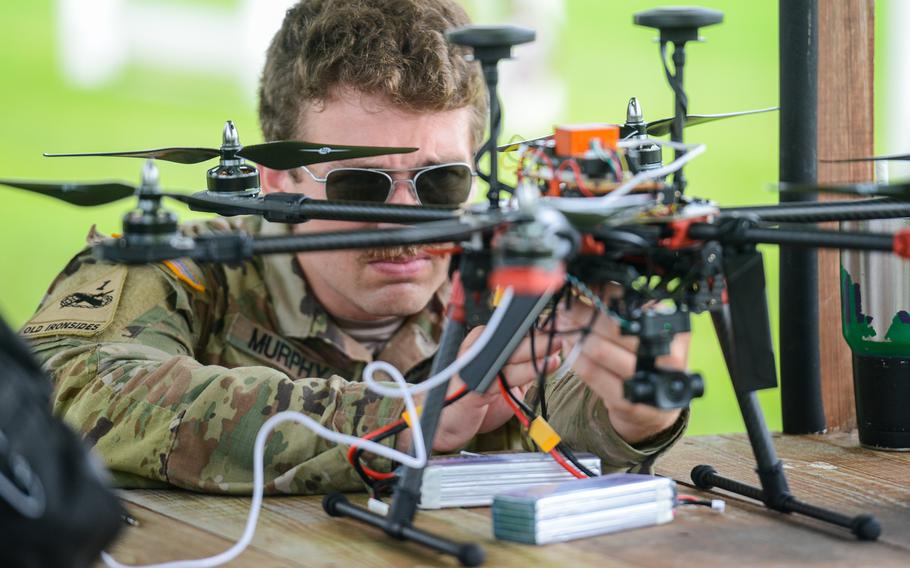
Army Sgt. Nicholas Murphy of the 3rd Infantry Division’s Combat Aviation Brigade tinkers with a hexacopter drone that he built on July 26, 2024, just before a test flight at a Hinesville, Ga., airfield just outside Fort Stewart. Murphy participated in a first-of-its-kind drone building class run by the division’s Marne Innovation Center at Fort Stewart. (Corey Dickstein/Stars and Stripes)
Murphy was one of eight 3rd ID soldiers who participated in the class late last month, which was launched to give soldiers an opportunity to better understand the kind of technology that has been proving increasingly critical for use on modern battlefields. Small drones have become ubiquitous on front lines from eastern Ukraine to Gaza to Syria, where troops — Americans, their allies and their enemies — have used the widely available, cheap tech to gather intelligence on opposing forces, drop small munitions or test enemy defenses.
The Army has spent recent years focused heavily on incorporating small drones into its formations, including front-line combat units, and studying the different ways they can be used in battle. The service has also worked extensively to improve its ability to find, track and destroy enemy small drones, which have proven hazardous to U.S. troops in places such as Afghanistan, Iraq and Syria.
The drones that the soldiers built at Fort Stewart span nearly 5 feet and weigh about 10 pounds. They are powered by two batteries and two GPS units and carry a high-definition camera, which could be swapped for other payloads, including small munitions or parts to carry medical supplies or ammunition, said Henry Sullivan, the chief products officer for the Alexandria, Va.-based training firm Building Momentum, which led the class.
When the five-day class started on a Monday, the soldiers arrived to find an array of boxes filled with parts and soldering equipment. Within a few days, the soldiers had taken those parts, soldered them together, wired them and mastered the software to fly them either by remote control or through autonomous programming. Sullivan said the class was designed for the soldiers to master quickly “all of the ifs, ands and buts” of their drones, whether they were previously familiar with unmanned systems or not.
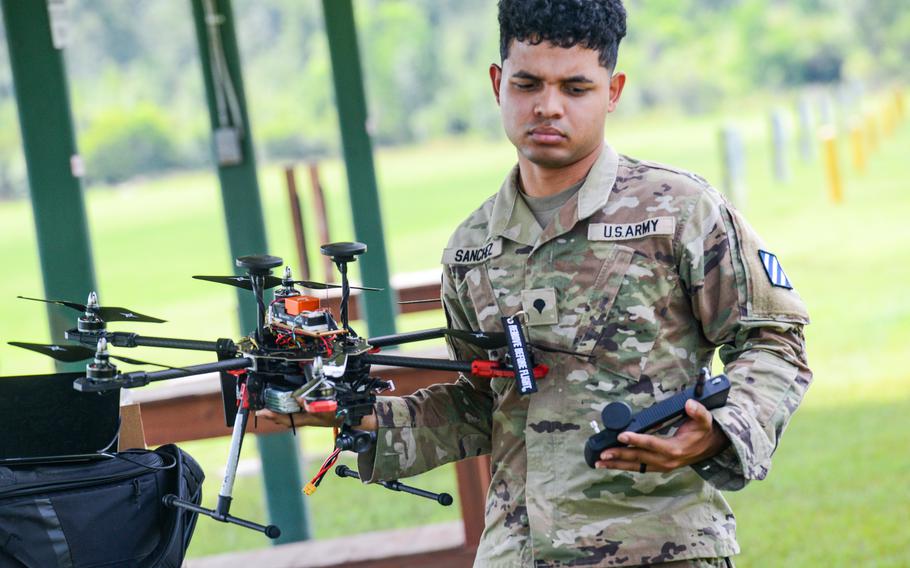
Army Spc. Adonis Sanchez prepares to fly a drone that he built during a small drone building class at Fort Stewart at a small airfield just off the Georgia Army post on July 26, 2024. The 3rd Infantry Division soldier was part of the inaugural drone building class run by the division’s Marne Innovation Center. (Corey Dickstein/Stars and Stripes)
For the 3rd Infantry Division, the soldiers who took the class are now expected to serve as a cadre from which other soldiers in the unit can learn drone building, said Maj. Donovan Blatherwick, who has led the Marne Innovation Center for the last year. The center, located inside Fort Stewart’s main post, offers soldiers on the base the abilities to pursue prototyping of innovations “to make their lives easier or make their jobs better” as well as training such as the drone-building course, he said.
Blatherwick envisions a division with thousands of soldiers who know how to build the small drones and employ them on the battlefield. He has had the Marne Innovation Center focused on small drones and robotics in recent months as the Army shifts toward building such technology into its close combat forces.
“There’s an infinite number of things you can put on a drone to turn it into a tool and the same with robotics, too. So that’s sort of where we’re headed,” said Blatherwick, a Special Forces officer assigned to the 3rd ID’s headquarters. “The sky’s the limit as far as what you want to do with any of these capabilities.”
Sullivan said a complete understanding of drone structures would be helpful on the battlefield, where small damage to drones can leave them out of service for weeks. Instead of having to send a broken drone back to a manufacturer — or at least a higher Army headquarters — the soldiers could fix the drones themselves within a couple of hours.
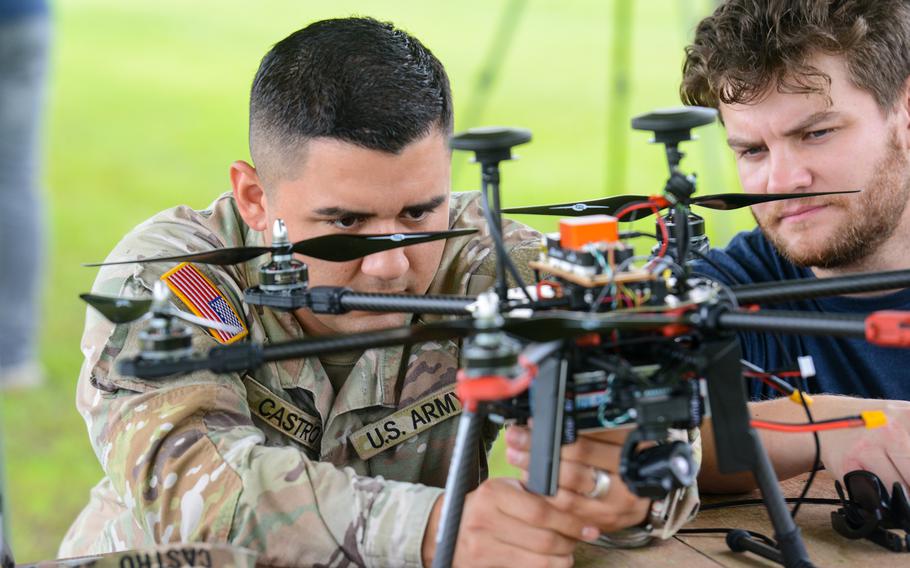
Army Pfc. Oscar Castro, left, and Henry Sullivan, the chief product officer with training firm Building Momentum, tinker with a hexacopter drone that Castro built just before a test flight at a Hinesville, Ga., airfield just outside Fort Stewart on July 26, 2024. Castro participated in a first-of-its-kind drone building class run by the division’s Marne Innovation Center at Fort Stewart. (Corey Dickstein/Stars and Stripes)
He believes the soldiers who took the class, with the right equipment, could now fix the drones that they built and others even in an austere, remote combat outpost. Most small unmanned systems from hexacopters to quadcopters to small fixed-wing drones run on the same kinds of electronics, Sullivan said.
“So, if it does crash or break, well, they’ve already built it so they know how to fix it. They actually know the parts they need to replace; they know the entire system from the build … to the firmware for the flight controller to how the software works,” he said. “So, if a soldier on the ground was equipped with the tools and knows these things these soldiers learned this week — they can come up with a good solution that can really make this experience work, even downrange. I think that’s really, really powerful.”
For Murphy, he counts the ability to build a drone from scratch as a critical new skill, but he was not certain yet how he would apply it to his work flying much larger drones. The sergeant has spent some 700 hours flying the Shadow, including on a 2017 deployment in eastern Afghanistan. The Shadow is a nearly 500-pound drone with a 20-foot wingspan typically used for reconnaissance, surveillance, target acquisition and battle damage assessment. The Army is in the process of retiring the more than 20-year-old drone in favor of newer systems.
“I’ve done stuff on a much larger scale as far as [unmanned aerial systems], so I wouldn’t say it’s directly beneficial to what I’ve done,” he said. “But I think it helps you understand the teamwork aspect of all of this, and … how teams can use these small [drones].”
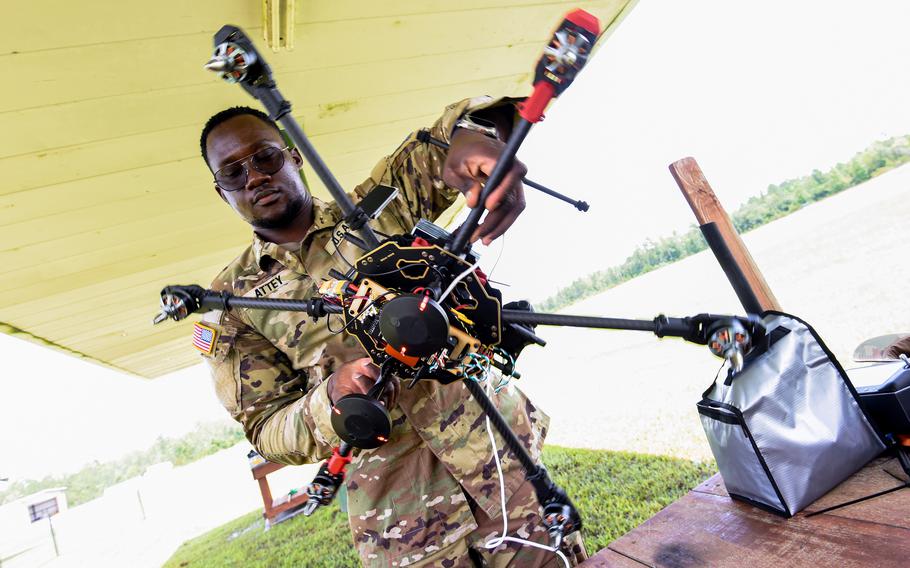
Army Spc. Oria Attey prepares his drone for a test flight in Georgia at a Hinesville airfield on July 26, 2024. Attey of the 3rd Infantry Division participated in a first-of-its-kind drone building class run by the division’s Marne Innovation Center at Fort Stewart. (Corey Dickstein/Stars and Stripes)
Army Spc. Malakhi Perry, however, believes understanding the ins and outs of small drones could be very beneficial to his job as an artillery forward observer. Perry, who serves with the 3rd ID’s 2nd Heavy Brigade Combat Team, said small drones such as the hexacopter that he built in the class could prove helpful in finding targets on the battlefield that forward observers might not be able to see directly.
Being able to fix the drone in the field, he said, could be a game changer.
“Right now, it’s a long pipeline if one of our drones goes down, which means for an operation, I probably no longer have that capability,” Perry said. “A system like this, where we put it together, where we understand it completely — it’s a quick fix and now my drone’s back up in the air.”
Perry believes he could fix most damage to his newly built drone within about 45 minutes. The Marne Innovation Center is also working on prefabricating parts for the drones with its 3D printers that could cut repair times down to 10 to 15 minutes in most cases, he said.
There’s another advantage to understanding how the small drones work, Perry said. It could help soldiers better understand how enemy forces will use the drones and how to spot and defeat them — one of the Army’s highest priorities.
“I think this is going to be a huge advantage for what we can do as a force,” Perry said. “Understanding these drones, how to build them, now I can understand a little better how to counter them, too. And that could greatly improve what the force is able to do in these environments where drones are becoming the main fight.”
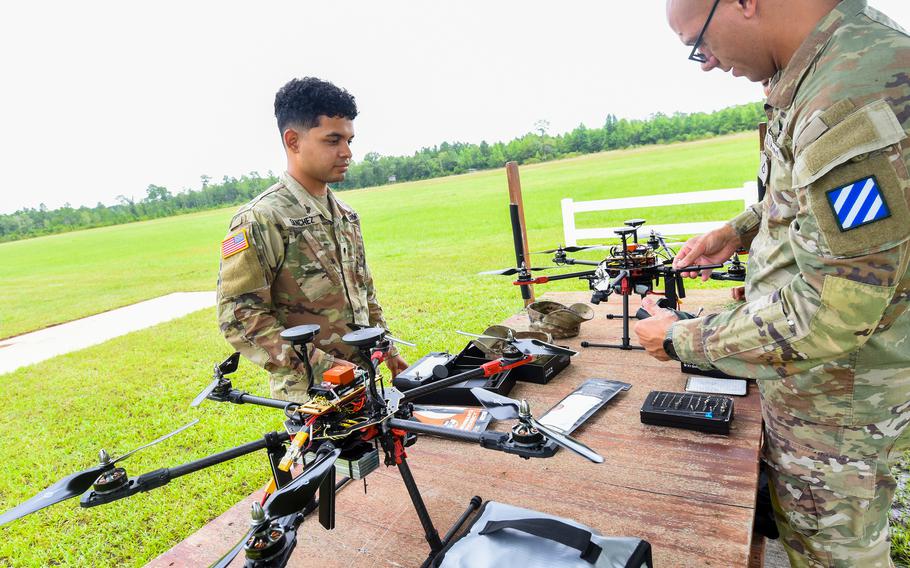
Army Spc. Adonis Sanchez, left, and Pfc. Jacob Morgan prepare the hexacopter drones that they built during a small drone building class at Fort Stewart for flight at a small airfield just off the the Georgia Army post on July 26, 2024. The 3rd Infantry Division soldiers were part of the inaugural drone building class run by the division’s Marne Innovation Center. (Corey Dickstein/Stars and Stripes)